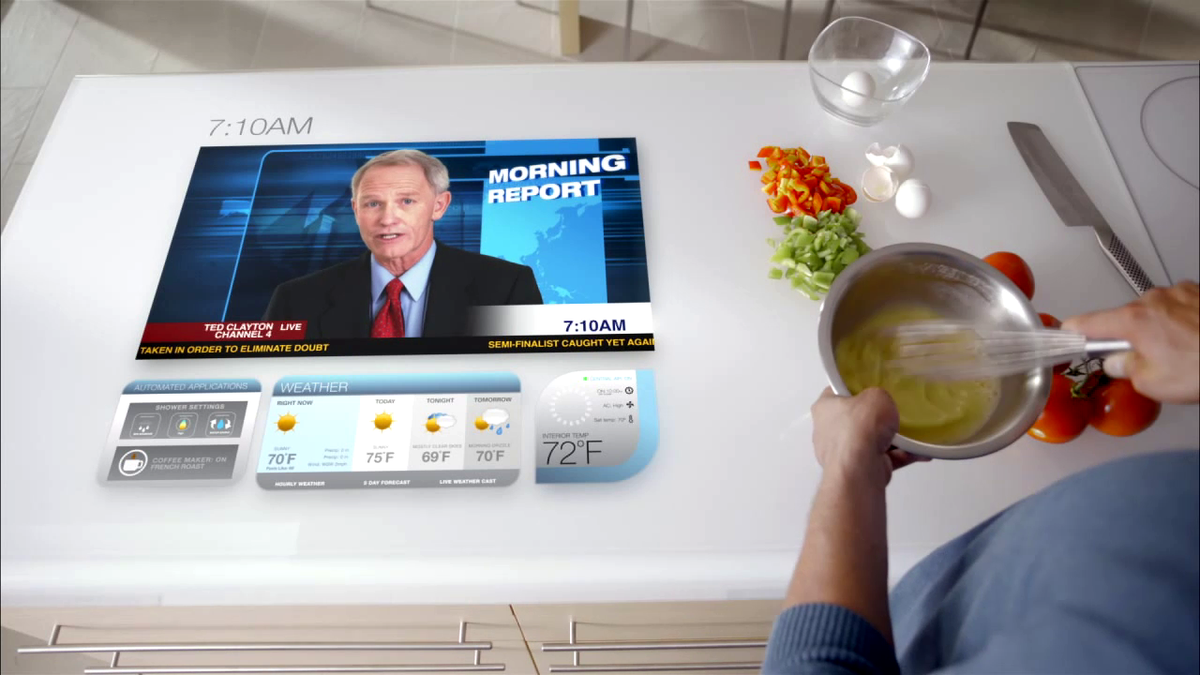
The home of the future will include computers in counter tops, according to one company's vision of what will be. (Corning)
Robots to help feed you, keep you safe, brush your teeth? Fat chance. In the near future, your home itself is that robot.
Rosie from "The Jetsons" had better look for a new job.
New research from businesses, corporations, and schools suggests that in the not-too-distant future, the digital home will adjust itself to meet your needs, provide new forms of surveillance and video communication, and manage energy use more effectively.
“The home will sense humans and know our gestures and actions," Jonathan Cluts, the director of consumer prototyping and strategy at Microsoft, told FoxNews.com.
Cluts, who is in charge of the Microsoft Home project, says radio ID tags will rule the roost in the future, communicating with central computers to let you know that the refrigerator is running low on milk.
He says the kitchen countertop will automatically recognize appliances, too, such as a food processor, and pop up instructions and tips on a countertop display. When you lay out ingredients, a computer will offer recipes based on what you have available and a history of your personal tastes. In the next few years, computers might be able to predict these preferences -- and even suggest that you buy more eggs.
Corning, which makes glass displays used in smartphones and televisions, released a video that shows just how this whole system could work in the digital home.
The video shows touchscreens all around the kitchen, bedrooms, living room, and even in the car. Dr. Peter Bocko, the chief technology officer at Corning, told FoxNews.com that the video is partly imagination. But it also includes real ideas the company is actively developing.
“All of these applications are possible using technology today, but there are challenges with form factor and cost,” Bocko said, explaining that touchscreens would use special-purpose Corning glass that can be wiped clean and is highly durable. Circuits similar to those used in the iPad would provide touchscreen inputs.
Pervasive computing in the home
Bruce McMillin, a computer engineering professor at Missouri University of Science and Technology, doesn't think the future digital home will have so many screens -- we won't need to see computers at all, he said.
“Computing will be so pervasive, you won’t even know there is a computer,” McMillin told FoxNews.com.
He describes a future home that will sense your needs. Say you're cold and reach for a sweater; the home might automatically raise the heat, based partly on your customized energy profile. And your house could maintain different temperatures for family members in a different room, ultimately leading to better energy management. “The house will have a symbiotic relationship with you,” McMillin said.
Incredibly, these customizations will work best for the elderly at first: responding to a need for more blood circulation by vibrating the bed, offering reminders to take medicine, and even monitoring whether someone is walking around and getting enough exercise during the day.
This concept is a stark departure from the future home shown in movies, where a robot tends to our needs. Instead, the home itself acts as a robot and adjusts to our wishes. Another example: The house could sense if someone falls, based on the rapid motion and a cry for help, and call 911.
Indeed, Cluts believes one of the most exciting future home technologies has to do with spoken commands. Walk into a room and ask to dim the lights, turn on the news, and read your daily e-mail -- your house will take it from there.
Cluts has a prototype of this working already.
To speak commands, you first say the name “Grace” -- a nod to computing pioneer Grace Hopper -- and let the built-in computers do the rest.
Making it a reality
Of course, all of these ideas sound appealing, but when will they be available outside of Microsoft's egghead labs?
In some ways, the technology is already here: Logitech makes a powerful video camera called Logitech Alert that senses motion and can stream video to your smartphone.
Control4 already makes products that use a wireless network technology called Zigbee that can help you monitor your home. For example, a front-door system knows when someone tries to tap in the code to your house or when you leave the garage door open. The system can alert you via text message or e-mail, too. One of the most interesting developments are sensors in kitchen appliances that can check to see when it is the best time to run the ice maker based on peak energy usage.
A company called Ciil makes weatherproof outdoor HD televisions you can install on your deck to keep tabs on the latest news. And Sub-Zero is working on smart appliances that use Control4 sensors and can adjust energy consumption during the day.
Cluts says the digital home is still just "getting there," although it's not that far off: Many of these far future innovations will be available by 2015 or 2020. As Bokco noted, cost is the limiting factor -- but not our imagination.
